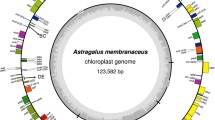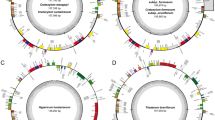Abstract
Chalcone synthase (CHS) genes in Petunia hybrida comprise a multigene family containing at least 7 complete members in the strain Violet 30 (V30). Based on a high sequence homology in both coding and non-coding sequence, a number of CHS genes can be placed into two subfamilies. By restriction fragment length polymorphism (RFLP) analysis it was shown that both chromosomes II and V carry one of these subfamilies, in addition to the other CHS genes identified so far. Members of a subfamily were found to be closely linked genetically. Analysis of the Petunia species that contributed to the hybrid nature of P. hybrida (P. axillaris, P. parodii, P. inflata and P. violacea) shows that none of the CHS gene clusters is specific for either one of the parents and therefore did not arise as a consequence of the hybridization. The number of CHS genes within a subfamily varies considerably among these Petunia species. From this we infer that the CHS subfamilies arose from very recent gene duplications.
Similar content being viewed by others
References
Bernatzky R, Tanksley SD: Toward a saturated linkage map in tomato based on isozymes and random cDNA sequences. Genetics 112: 887–898 (1986).
Burr B, Burr FA, St John TP, Thomas M, Davis RW: Zein storage protein gene family of maize. An assessment of heterogeneity with cloned messenger RNA sequences. J Mol Biol 154: 33–49 (1982).
Chappell J, Hahlbrock K: Transcription of plant defence genes in response to UV light or fungal elicitor. Nature 311: 76–78 (1984).
Cornu A, Farcy E, Mousset C: Genetics (in press) (1987).
DeVlaming P, Gerats AGM, Wiering H, Wijsman HJW: Petunia hybrida: A short description of the action of 91 genes, their origin and their map location. Plant Mol Biol Rep 2: 21–42 (1984).
Dean C, van denElzen P, Tamaki S, Dunsmuir P, Bedbrook J: Linkage and homology analysis divides the eight genes for the small subunit of petunia ribulose 1,5-bisphosphate carboxylase into three gene families. Proc Natl Acad Sci USA 82: 4964–4968 (1985).
Dean C, van denElzen P, Tamaki S, Dunsmuir P, Bedbrook J: Differential expression of the eight genes of the petunia ribulose bisphosphate carboxylase small subunit multi-gene family. EMBO J 4: 3055–3061 (1985).
Dellaporta SJ, Wood J, Hicks JB: A plant minipreparation: Version II. Plant Mol Biol Rep 1: 19–21 (1983).
Dixon RA: The phytoalexin response: elicitation, signalling and control of host gene expression. Biol Rev 61: 239–291 (1986).
Dunsmuir P, Smith SM, Bedbrook J: The major chlorophyll a/b-binding protein of Petunia is composed of several polypeptides encoded by a number of distinct nuclear genes. J Mol Appl Genet 2: 285–300 (1983).
Dunsmuir P: The petunia chlorophyll a/b-binding protein genes: a comparison of cab genes from different gene families. Nucl Acids Res 13: 2503–2519 (1985).
Ebel J: Phytoalexin synthesis: the biochemical analysis of the induction process. Ann Rev Phytopathol 24: 235–264 (1986).
Firmin JL, Wilson KE, Rossen L, Johnston AWB: Flavonoid activation of nodulation genes in Rhizobium reversed by other components present in plants. Nature 324: 90–92 (1986).
Hagen G, Rubinstein I: Complex organization of zein genes in maize. Gene 13: 239–249 (1981).
Harborne JB: Nature, distribution and function of plant flavonoids. In: Cody V, Middleton E, Harborne JB (eds) Plant Flavonoids in Biology and Medicine. Alan R. Liss, Inc., New York (1986) pp 15–24.
Heller W, Hahlbrock K: Highly purified “flavanone synthase” from parsley catålyzes the formation of naringenin chalcone. Arch Biochem Biophys 200: 617–619 (1980).
Hoffman LM, Donaldson DD: Characterization of Phaseolus vulgaris phytohemagglutinin genes closely linked on the chromosome. EMBO J 4: 883–889 (1985).
Koes RE, Spelt CE, Reif HJ, van denElzen PJM, Veltkamp E, Mol JNM: Floral tissue of Petunia hybrida (V30) expresses only one member of the chalcone synthase multigene family. Nucl Acids Res 14: 5229–5239 (1986).
Lee JS, Brown GG, Verma DPS: Chromosomal arrangement of leghemoglobin genes in soybean. Nucl Acids Res 11: 5541–5553 (1983).
Leutwiler LS, Meyerowitz EM, Tobin EM: Structure and expression of the three light-harvesting chlorophyll a/b-binding protein genes in Arabidopsis thaliana. Nucl Acids Res 14: 4051–4064 (1986).
Maniatis T, Fritsch EF, Sambrook J: Molecular Cloning: a Laboratory Manual. Cold Spring Harbor Laboratory, Cold Spring Harbor, New York (1982).
Mol JNM, Schram AW, deVlaming P, Gerats AGM, Kreuzaler F, Hahlbrock K, Reif HJ, Veltkamp E: Regulation of flavonoid gene expression in Petunia hybrida: description and partial characterization of a conditional mutant in chalcone synthase gene expression. Mol Gen Genet 192: 424–429 (1983).
Peters NK, Frost JW, Long SR: A plant flavone, luteolin, induces expression of Rhizobium meliloti nodulation genes. Science 233: 977–980 (1986).
Polans NO, Weeden NF, Thompson WF: Inheritance, organization, and mapping of rbcS and cab multigene families in pea. Proc Natl Acad Sci USA 82: 5083–5087 (1985).
Reif HJ, Niesbach U, Deumling B, Saedler H: Cloning and analysis of two genes for chalcone synthase from Petunia hybrida. Mol Gen Genet 199: 208–215 (1985).
Sink KC: Taxonomy. Monographs on Theoretical and Applied Genetics: Petunia. Springer Verlag, Berlin (1984) pp 3–7.
Schram AW, Jonsson LMV, Bennink GJH: Biochemistry of flavonoid synthesis in Petunia hybrida. In: Sink KC (ed.) Taxonomy. Monographs on Theoretical and Applied Genetics: Petunia. Springer Verlag, Berlin (1984) pp 68–75.
Talbot DR, Adjang MJ, Slightom JL, Hall TC: Size and organization of a multigene family encoding phaseolin, the major seed storage protein of Phaseolus vulgaris L. Mol Gen Genet 198: 42–49 (1984).
Vallejos CE, Tanksley SD, Bernardsky R: Localization in the tomato genome of DNA restriction fragments containing sequences homologous to the rRNA (45S), the major chlorophyll a/b-binding polypeptide and the ribulose bisphosphate carboxylase genes. Genetics 112: 93–105 (1986).
Wiering H, deVlaming P: Inheritance and biochemistry of pigments. In: Sink KC (ed.) Taxonomy. Monographs on Theoretical and Applied Genetics: Petunia. Springer Verlag, Berlin (1984) pp 49–65.
Author information
Authors and Affiliations
Rights and permissions
About this article
Cite this article
Koes, R.E., Spelt, C.E., Mol, J.N.M. et al. The chalcone synthase multigene family of Petunia hybrida (V30): sequence homology, chromosomal localization and evolutionary aspects. Plant Mol Biol 10, 159–169 (1987). https://doi.org/10.1007/BF00016153
Received:
Accepted:
Issue Date:
DOI: https://doi.org/10.1007/BF00016153




